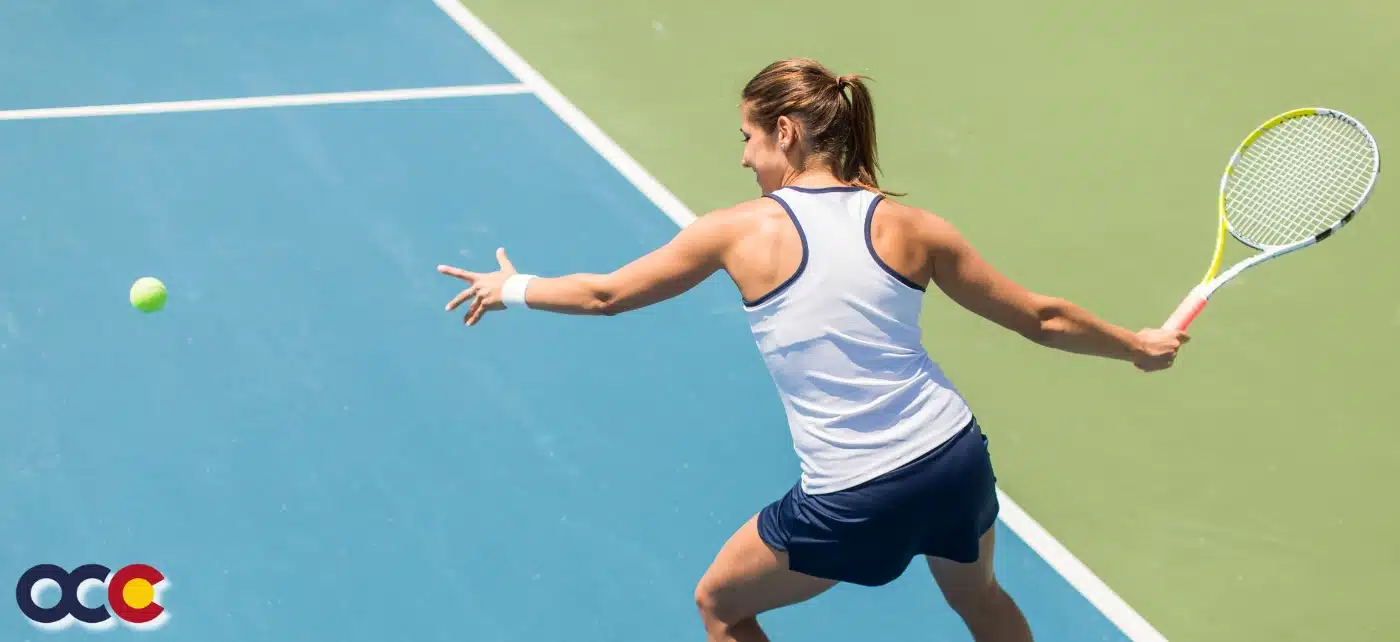As the snow melts and the days grow longer, Colorado sports enthusiasts eagerly dust off their tennis rackets, golf clubs, and pickleball paddles, ready to embrace their favorite spring sports.
This surge of activity, while invigorating, brings with it a heightened risk of rotator cuff injuries, which can dampen the start of your season. The rotator cuff, a crucial group of muscles and tendons stabilizing the shoulder, is particularly vulnerable during the repetitive and often vigorous movements characteristic of tennis, golf, and pickleball – among other sports.
The excitement of getting outside and back on the course or court can sometimes lead athletes to overlook the importance of easing into their routines, inadvertently setting the stage for injury. If you are transitioning from a relatively sedentary winter to a full spring sports schedule, take a cautious approach to prevent the strain that can lead to rotator cuff injuries.
Even if you’ve been active all winter on the slopes or in the gym, it often takes a few weeks to adjust to your new spring routine. Gradually increasing the intensity and duration of play allows your body, and especially your shoulders, to adapt and strengthen, reducing the risk of injury.
Start with some specific warm-up exercises targeting the shoulder muscles to strengthen and protect your rotator cuff against the demands an active lifestyle. This approach not only enhances performance but can also prevent potential setbacks caused by rotator cuff injuries, ensuring that the joy of your spring sports season is not interrupted.
How does the rotator cuff work?
Imagine your shoulder as a golf ball sitting on a golf tee. This ball-and-socket joint gives your arm a wide range of motion, allowing you to swing, throw, and lift. Key players in keeping this ball in place are the muscles and tendons of the rotator cuff. Think of the rotator cuff as a group of four muscles, each with a specific role, working together to stabilize and move your arm. These are small but mighty muscles that wrap around the top of your arm bone, holding it snugly in the shoulder socket.
When you throw a ball or reach with your racquet to hit a serve, your rotator cuff muscles spring into action. They not only keep your arm bone centered in the shoulder socket but also help lift and rotate your arm. Each muscle contributes to a different movement, ensuring your shoulder can handle tasks ranging from brushing your hair to swinging a tennis racket or golf club.
This intricate teamwork is essential for the smooth operation of your shoulder. Without a healthy, functioning rotator cuff, even simple activities could become painful or impossible. That’s why understanding the basics of this muscle group and how to keep it strong and flexible is crucial, especially as we head into the spring sports season.
Early season routines can safeguard rotator cuff health
Preventive Measures
Engaging in specific exercises that enhance flexibility and build muscle strength can drastically reduce the risk of rotator cuff injuries. Incorporating shoulder stretches and resistance band exercises into daily workouts strengthens these muscles, making them more resilient to the stresses of sports activities. Here are four exercises you can do now to strengthen and increase flexibility as you ramp up for spring.
Note: Tailoring these exercises to your individual needs is the best way to prevent rotator cuff injuries, setting you up for a successful and injury-free season. Consult your doctor or physical trainer if you are new to these kinds of exercises or have had rotator cuff injuries in the past.
- Internal and External Rotation: Using a resistance band, secure one end and hold the other. Keep your elbow at a 90-degree angle close to your side. For internal rotation, pull the band towards your body, and for external rotation, move it away. Perform 10-15 repetitions on each arm.
- Pendulum Stretch: Stand, leaning slightly forward, allowing your arm to hang down. Start a series of small movements, letting momentum guide your arm in gentle circles. Gradually increase the diameter of these circles as comfort allows. This exercise aids in reducing stiffness and improving range of motion without placing undue stress on the rotator cuff.
- Cross-body Reach: Sit or stand, using one arm to lift the other arm at the elbow, and gently bring it across your body, stretching the shoulder. Hold the stretch for 15-30 seconds and repeat 3-5 times. This maneuver targets the posterior part of the rotator cuff, promoting flexibility.
- Scapular Squeeze: Standing or sitting with arms at your sides, squeeze your shoulder blades together as if trying to hold a pencil between them. Hold this position for 5-10 seconds before releasing. Repeat 10-15 times. This exercise strengthens the scapular muscles, which are crucial for rotator cuff health and overall shoulder stability. Incorporating these exercises (and other rotator cuff exercises!) into your routine lays a foundation for preventing future injuries.
What to do if you injured your rotator cuff: Treatment Options
Getting back outside for spring sports is a great way to be active. Putting in the work to prepare your body will minimize your chances of a rotator cuff injury.
But, in the event you do get injured, there are things you can do to rest, repair and recover. If you suspect you have a rotator cuff injury – which may be characterized by pain or lack of strength or mobility in the shoulder – schedule time with an orthopedic specialist to confirm a diagnosis and obtain a treatment plan.
They will provide a comprehensive evaluation and a personalized recommendation for treatment and recovery. There are many different types of rotator cuff injuries, and treatment can range from rest and immobilization to surgery.
If rotator cuff surgery is needed, your orthopedic will recommend you complete physical therapy exercises to complete your recovery. If you’re having shoulder pain and suspect a rotator cuff injury, getting a professional diagnosis is recommended. Contact the shoulder and rotator cuff experts at Advanced Orthopedics and Sports Medicine Specialists to schedule an appointment today.


















